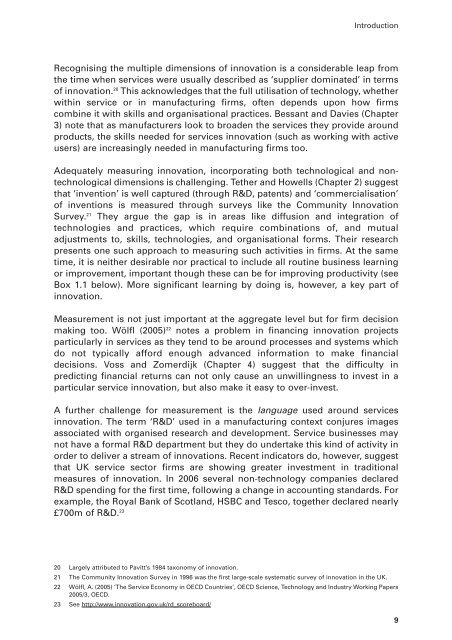Innovation in Services - Department for Business, Innovation and Skills
Innovation in Services - Department for Business, Innovation and Skills
Innovation in Services - Department for Business, Innovation and Skills
You also want an ePaper? Increase the reach of your titles
YUMPU automatically turns print PDFs into web optimized ePapers that Google loves.
Introduction<br />
Recognis<strong>in</strong>g the multiple dimensions of <strong>in</strong>novation is a considerable leap from<br />
the time when services were usually described as ‘supplier dom<strong>in</strong>ated’ <strong>in</strong> terms<br />
of <strong>in</strong>novation. 20 This acknowledges that the full utilisation of technology, whether<br />
with<strong>in</strong> service or <strong>in</strong> manufactur<strong>in</strong>g firms, often depends upon how firms<br />
comb<strong>in</strong>e it with skills <strong>and</strong> organisational practices. Bessant <strong>and</strong> Davies (Chapter<br />
3) note that as manufacturers look to broaden the services they provide around<br />
products, the skills needed <strong>for</strong> services <strong>in</strong>novation (such as work<strong>in</strong>g with active<br />
users) are <strong>in</strong>creas<strong>in</strong>gly needed <strong>in</strong> manufactur<strong>in</strong>g firms too.<br />
Adequately measur<strong>in</strong>g <strong>in</strong>novation, <strong>in</strong>corporat<strong>in</strong>g both technological <strong>and</strong> nontechnological<br />
dimensions is challeng<strong>in</strong>g. Tether <strong>and</strong> Howells (Chapter 2) suggest<br />
that ‘<strong>in</strong>vention’ is well captured (through R&D, patents) <strong>and</strong> ‘commercialisation’<br />
of <strong>in</strong>ventions is measured through surveys like the Community <strong>Innovation</strong><br />
Survey. 21 They argue the gap is <strong>in</strong> areas like diffusion <strong>and</strong> <strong>in</strong>tegration of<br />
technologies <strong>and</strong> practices, which require comb<strong>in</strong>ations of, <strong>and</strong> mutual<br />
adjustments to, skills, technologies, <strong>and</strong> organisational <strong>for</strong>ms. Their research<br />
presents one such approach to measur<strong>in</strong>g such activities <strong>in</strong> firms. At the same<br />
time, it is neither desirable nor practical to <strong>in</strong>clude all rout<strong>in</strong>e bus<strong>in</strong>ess learn<strong>in</strong>g<br />
or improvement, important though these can be <strong>for</strong> improv<strong>in</strong>g productivity (see<br />
Box 1.1 below). More significant learn<strong>in</strong>g by do<strong>in</strong>g is, however, a key part of<br />
<strong>in</strong>novation.<br />
Measurement is not just important at the aggregate level but <strong>for</strong> firm decision<br />
mak<strong>in</strong>g too. Wölfl (2005) 22 notes a problem <strong>in</strong> f<strong>in</strong>anc<strong>in</strong>g <strong>in</strong>novation projects<br />
particularly <strong>in</strong> services as they tend to be around processes <strong>and</strong> systems which<br />
do not typically af<strong>for</strong>d enough advanced <strong>in</strong><strong>for</strong>mation to make f<strong>in</strong>ancial<br />
decisions. Voss <strong>and</strong> Zomerdijk (Chapter 4) suggest that the difficulty <strong>in</strong><br />
predict<strong>in</strong>g f<strong>in</strong>ancial returns can not only cause an unwill<strong>in</strong>gness to <strong>in</strong>vest <strong>in</strong> a<br />
particular service <strong>in</strong>novation, but also make it easy to over-<strong>in</strong>vest.<br />
A further challenge <strong>for</strong> measurement is the language used around services<br />
<strong>in</strong>novation. The term ‘R&D’ used <strong>in</strong> a manufactur<strong>in</strong>g context conjures images<br />
associated with organised research <strong>and</strong> development. Service bus<strong>in</strong>esses may<br />
not have a <strong>for</strong>mal R&D department but they do undertake this k<strong>in</strong>d of activity <strong>in</strong><br />
order to deliver a stream of <strong>in</strong>novations. Recent <strong>in</strong>dicators do, however, suggest<br />
that UK service sector firms are show<strong>in</strong>g greater <strong>in</strong>vestment <strong>in</strong> traditional<br />
measures of <strong>in</strong>novation. In 2006 several non-technology companies declared<br />
R&D spend<strong>in</strong>g <strong>for</strong> the first time, follow<strong>in</strong>g a change <strong>in</strong> account<strong>in</strong>g st<strong>and</strong>ards. For<br />
example, the Royal Bank of Scotl<strong>and</strong>, HSBC <strong>and</strong> Tesco, together declared nearly<br />
£700m of R&D. 23<br />
20 Largely attributed to Pavitt’s 1984 taxonomy of <strong>in</strong>novation.<br />
21 The Community <strong>Innovation</strong> Survey <strong>in</strong> 1996 was the first large-scale systematic survey of <strong>in</strong>novation <strong>in</strong> the UK.<br />
22 Wölfl, A. (2005) ‘The Service Economy <strong>in</strong> OECD Countries’, OECD Science, Technology <strong>and</strong> Industry Work<strong>in</strong>g Papers<br />
2005/3, OECD.<br />
23 See http://www.<strong>in</strong>novation.gov.uk/rd_scoreboard/<br />
9
















